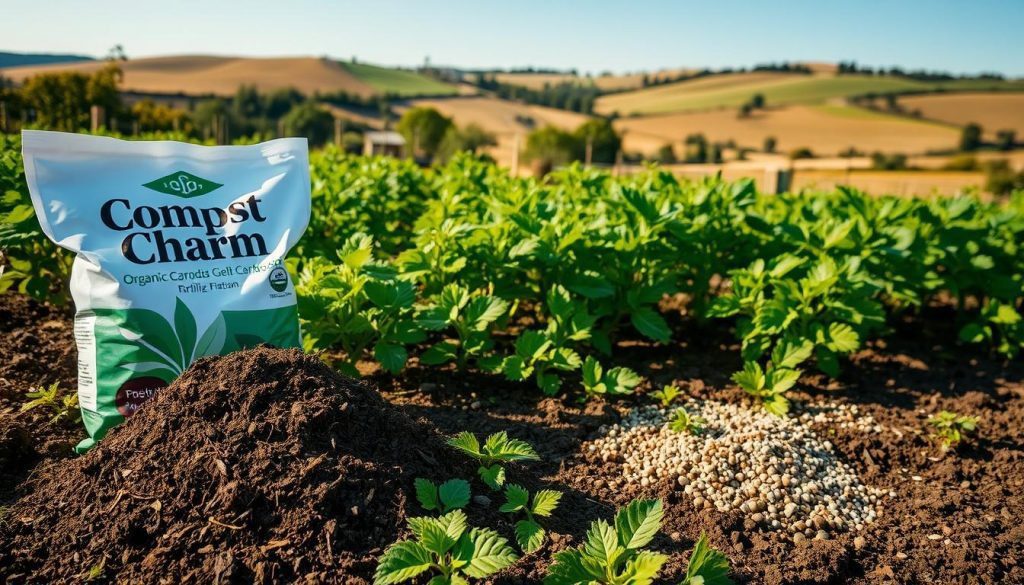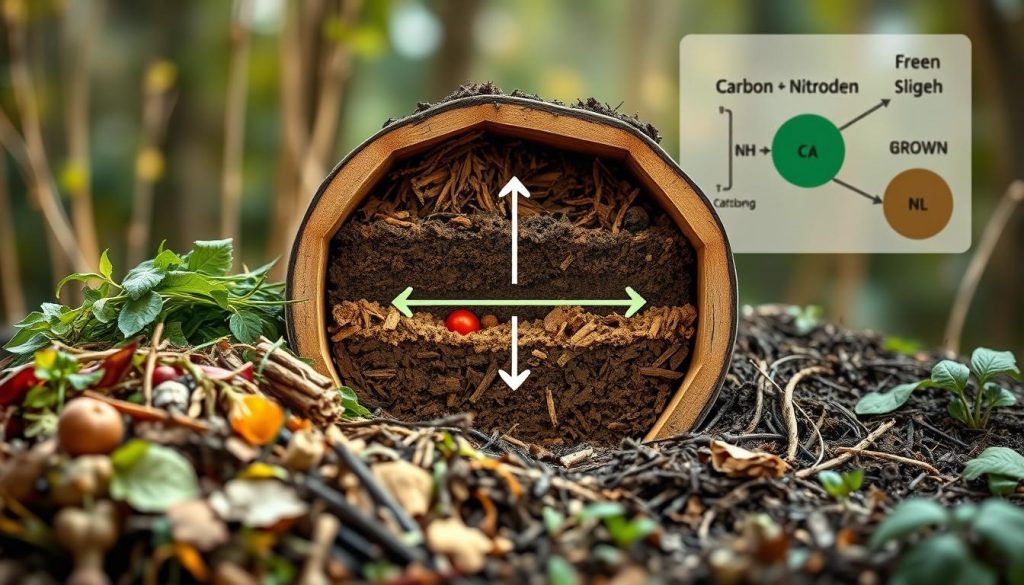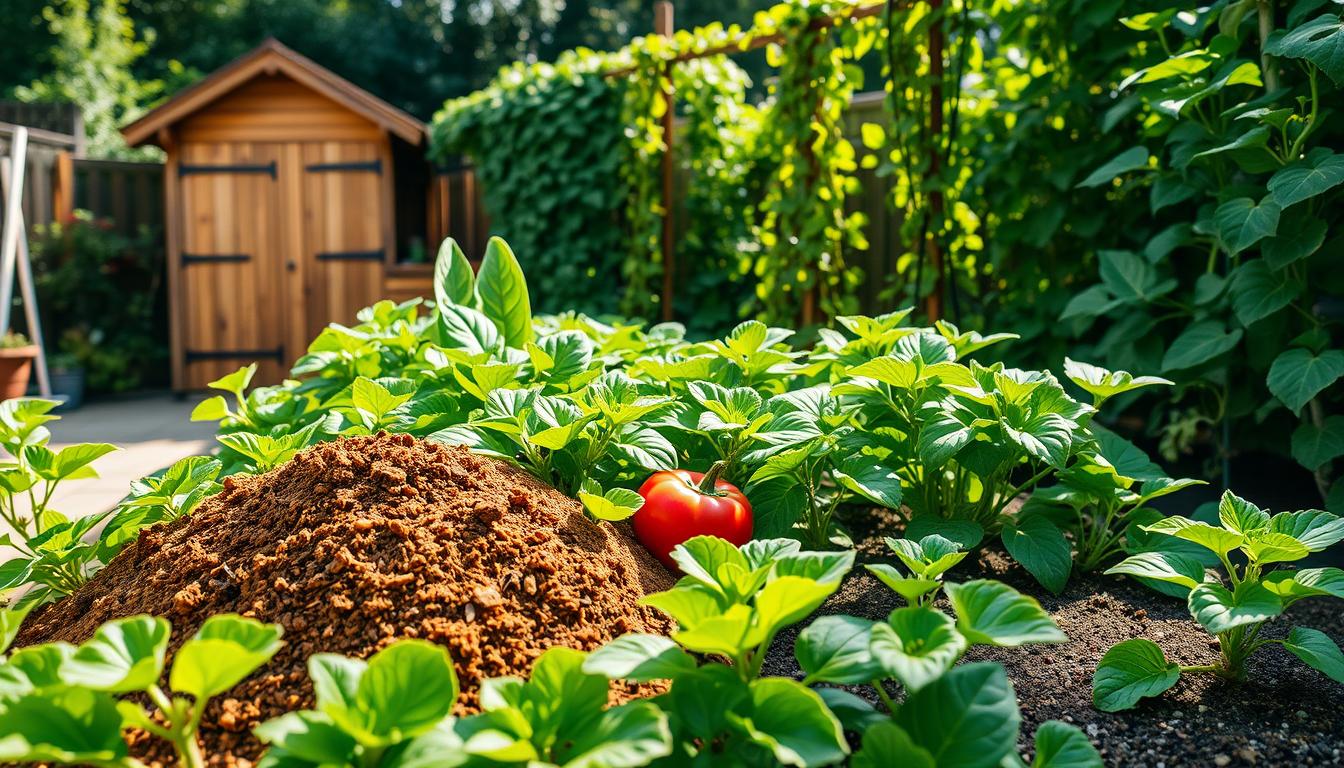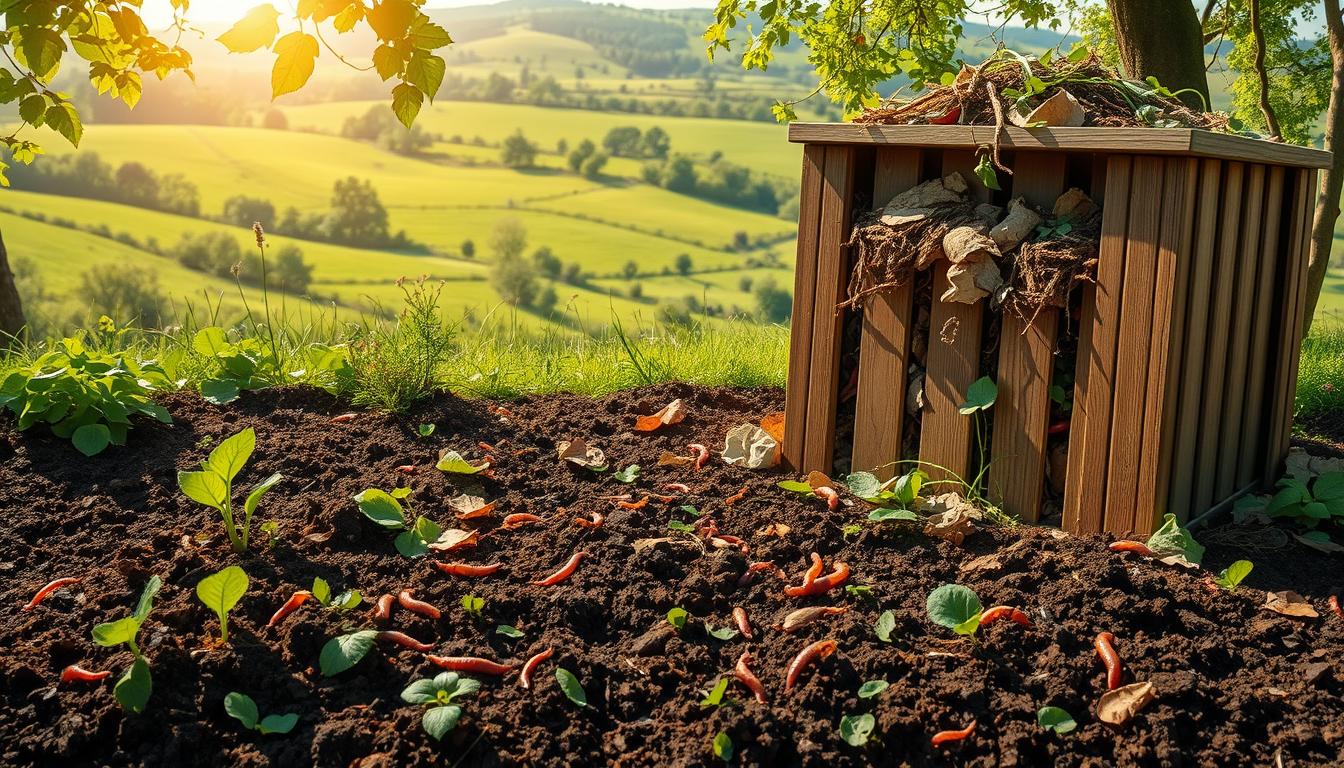Are you turning your kitchen scraps and yard waste into nutrient-rich soil? Or are you letting them go to waste?
As a gardener, I’ve often wondered about the best way to compost.
Composting is a simple and effective way to reduce waste and create a sustainable gardening practice.
But, have you ever stopped to think about the importance of balancing “green” and “brown” materials in your compost pile?
The difference between green and brown composting materials is crucial to creating a healthy compost pile.
In this article, we’ll explore the benefits and differences of each type.
This will help you optimize your composting process.
Key Takeaways
- Understanding the role of green and brown materials in composting
- Benefits of balancing green and brown composting materials
- Tips for optimizing your composting process
- Common mistakes to avoid in green vs brown composting
- Best practices for maintaining a healthy compost pile
The Fundamentals of Successful Composting
Composting is all about creating a perfect spot for tiny organisms to break down organic stuff. It’s about mixing different materials, known as “green” and “brown” composting materials.
The Decomposition Process Explained
The breakdown process relies on tiny life forms like bacteria and fungi. They need a mix of carbon and nitrogen to grow.
“Brown” materials, rich in carbon, give energy. “Green” materials, rich in nitrogen, help microbes grow.
A good compost pile has both “green” and “brown” stuff. Aim for 2/3 “brown” and 1/3 “green” materials. This balance is key.
| Material Type | Carbon/Nitrogen Content | Examples |
|---|---|---|
| Green Materials | High Nitrogen | Food scraps, grass clippings |
| Brown Materials | High Carbon | Dried leaves, straw |
Why Balanced Composting Transforms Your Garden
Balanced compost makes your garden soil better. It’s full of nutrients that help plants grow. Compost can also make soil hold more water and improve its structure.
Keeping your compost balanced stops bad smells and pests. It also makes composting faster and more effective.
This means better compost for your garden.
What is Green vs Brown in Composting?
To make a great compost pile, you need to know about green and brown materials. Composting turns organic stuff into a soil that’s full of nutrients.
It’s all about mixing ‘green’ stuff, which has lots of nitrogen, with ‘brown’ stuff, which has lots of carbon.
Green Materials: The Nitrogen Providers
Green materials are wet and full of nitrogen. They include kitchen scraps, grass clippings, and manure from animals that eat plants.
These items help because they give nitrogen to the microbes that break down the compost.
Here’s a table showing some green materials and how much nitrogen they have:
| Material | Nitrogen Content (%) |
|---|---|
| Grass Clippings | 3-4 |
| Kitchen Scraps | 2-3 |
| Manure (Herbivore) | 2-4 |
Brown Materials: The Carbon Contributors
Brown materials are dry and full of carbon. They include dried leaves, straw, shredded newspaper, and cardboard.
These items are important because they give carbon to the microbes, balancing out the nitrogen from green materials.
A mix of brown materials keeps the compost pile from getting too wet or smelly.
Dried leaves are full of carbon and soak up extra moisture. Straw and shredded newspaper are also rich in carbon.
They help the compost pile’s structure by adding bulk.
Green Composting Materials in Detail
Green materials are key in composting because they are rich in nitrogen. This is what drives the composting process.
They help balance the carbon-to-nitrogen ratio, which is crucial for decomposition.
Common Green Materials You Can Use
Some top green materials include food scraps, grass clippings, and manure from herbivores. These are full of nitrogen, which is vital for the microorganisms that decompose the compost.
- Fresh grass clippings
- Kitchen scraps (fruits and vegetables)
- Manure from herbivores (e.g., horse or rabbit manure)
- Fresh leaves
- Green weeds
Nitrogen Content and Its Role in Decomposition
Nitrogen in green materials is key for decomposition. It’s a vital nutrient for microorganisms, helping break down organic matter.
Enough nitrogen ensures the composting process works well.
| Green Material | Nitrogen Content (%) |
|---|---|
| Grass Clippings | 3-4 |
| Kitchen Scraps | 2-3 |
| Manure (Herbivore) | 2-3 |
Potential Issues with Excess Green Materials
While green materials are vital, too much can cause problems. Issues like odor problems and nitrogen leaching can arise.
It’s important to balance green materials with brown ones for a healthy compost pile.
Brown Composting Materials in Detail
Brown materials are key in composting, adding carbon content. They are dry and rich in carbon, balancing out the nitrogen in green materials.
The right mix of brown and green materials is crucial for good composting.

Common Brown Materials for Your Compost Pile
Dried leaves, straw, shredded newspaper, and cardboard are common brown materials. They are carbon-rich and absorb moisture.
Using different brown materials makes your compost diverse and strong.
Wood ash, sawdust, and shredded branches are also good. But, avoid brown materials with chemicals or pesticides.
They can harm your compost’s microorganisms.
Carbon Content and Its Function in Composting
The carbon in brown materials feeds the decomposing microorganisms. These microorganisms break down the materials, releasing heat and carbon dioxide.
Carbon also balances nitrogen from green materials, creating a stable compost environment.
Challenges with Too Many Brown Materials
While brown materials are important, too much can slow down composting. Too much carbon means microorganisms lack nitrogen.
This can make your compost pile dry and slow, showing the need for a balanced mix of green and brown composting materials.
The Carbon to Nitrogen Ratio: Finding the Perfect Balance
Understanding the carbon to nitrogen ratio is crucial for a healthy compost pile. This ratio affects how well organic matter breaks down and the compost’s quality.
Microorganisms need a balance of carbon and nitrogen to work well.
The Science Behind the Ideal C:N Ratio
The ideal ratio for composting is between 25:1 and 30:1. This means for every 25-30 parts of carbon-rich materials, there should be 1 part of nitrogen-rich materials.
Carbon-rich materials give energy to microorganisms. Nitrogen-rich materials help them grow and reproduce.
A balanced ratio makes composting efficient and nutrient-rich.
It’s not just about the amount of carbon and nitrogen. The quality matters too. For example, woody materials are high in carbon but decompose slowly.
Green materials are high in nitrogen and decompose faster. Knowing these differences is key to finding the right balance.
Practical Methods to Measure and Adjust Your Ratio
To manage the C:N ratio, use a layering method. Start with a layer of brown materials, then green materials. Keep alternating until your pile is done.
Mixing materials well also works. Watch the pile’s temperature and moisture to check the ratio. Too hot or smelly? It’s too nitrogen-rich. Not heating up? It’s too carbon-rich.
| Material Type | Carbon Content | Nitrogen Content |
|---|---|---|
| Dried Leaves | High | Low |
| Grass Clippings | Low | High |
| Shredded Newspaper | High | Low |
| Kitchen Scraps | Medium | High |
Seasonal Strategies for Green and Brown Composting
Knowing how to handle green and brown composting materials with the seasons is key. It’s important to adjust our composting methods as the seasons change.
This helps keep our compost piles balanced and efficient.
Green and brown materials change with the seasons. We need to adjust our compost pile management accordingly.
Spring and Summer: Managing Abundant Green Materials
In spring and summer, gardens are full of green materials. This can upset the balance in your compost. To fix this, add more brown materials like dry leaves or shredded newspaper.
It’s also important to watch the moisture levels.
The compost can break down too fast, causing odors or pests if not managed right.
Fall and Winter: Utilizing Available Brown Materials
When fall and winter come, focus on using brown materials like leaves and branches. These materials are rich in carbon and help balance your compost.
Mix them with green materials like kitchen scraps or manure for the best mix.
| Season | Primary Materials | Composting Strategy |
|---|---|---|
| Spring/Summer | Green Materials | Balance with Brown Materials |
| Fall/Winter | Brown Materials | Layer with Green Materials |

By using these seasonal strategies, your compost pile will stay healthy and productive all year. This will make your garden soil rich and full of nutrients.
Composting Greens and Browns Ratio: Practical Applications
To make your compost pile work best, it’s important to know the greens and browns ratio. This means understanding the theory and how to use it every day.
Layering Techniques for Faster Decomposition
Layering is a great way to balance your compost pile. Start with 4-6 inches of brown materials at the bottom for airflow.
Then, add a layer of green materials, followed by browns again.
This pattern keeps the carbon-to-nitrogen ratio right. Keep repeating this until you end with a brown layer on top.
This helps control odors and moisture.
It’s crucial to check the moisture and temperature of your compost. It should be like a damp sponge and warm, between 130°F and 140°F.
Adjust your layers based on these to help it decompose well.
Mixing Methods for Different Composting Systems
Composting systems need different mixing methods. Outdoor piles can be mixed well with a pitchfork or shovel.
You don’t need to spend a fortune on good quality tools to turn your compost
But, indoor bins or worm composters need a gentler touch to protect the microorganisms or worms.
Regularly turning the compost in outdoor piles helps. For indoor bins, gentle mixing keeps the balance right.
In worm composting, finding the right balance is key. Too much green can be too acidic, while too much brown lacks nutrients.
The goal is to keep it balanced for the worms.
Managing Compost Green and Brown Materials
A good compost pile starts with sorting green and brown materials. This balance is key for effective decomposition. It also makes the compost better.
Creative Storage Solutions for Seasonal Materials
Storing green and brown materials well is crucial. Use bins or containers that are easy to reach. Keep them in a dry, shaded spot.
For example, store dried leaves in bins during fall. This keeps them dry and ready for use all year.
Using vertical space is smart. Stackable bins or pallet systems save space. They keep materials organized and make mixing easier.
Processing Techniques to Improve Decomposition Rates
To speed up decomposition, process your materials right. Shredding increases their surface area. This lets microorganisms break them down faster.
Also, pre-mix materials before adding them. Mixing green and brown materials in a bin helps balance the compost.
This is important for fast decomposition.
Sourcing Green and Brown Materials Year-Round
To make good compost, you need both green and brown materials all the time. You can find these by using community resources and being eco-friendly.
This keeps your compost pile balanced.
Community Resources for Composting Materials
Getting materials from your community is a smart move. Local gardening clubs might share or swap materials. Farms or stables can give you manure or bedding, which are full of nutrients.
Many cities also collect organic waste at the curb. This is a great way to get green materials.
Using community resources helps reduce waste and brings gardeners together. It lets people share tips and materials, making composting better for everyone.
Creating Your Own Sustainable Material Supply
It’s also important to grow your own compost materials. Add plants that are good for compost to your garden.
Legumes fix nitrogen, and straw or dead leaves add carbon.
By gardening and composting in a complete way, you can use less outside help. This makes your garden better and helps the planet too.

Environmental Impact of Green and Brown Composting
Composting is key for the environment, especially when mixing green and brown materials. It helps us reduce our impact on the planet.
By composting right, we can make a big difference.
Composting helps manage waste and supports the environment. It helps lock carbon in the soil and cuts down on landfill waste.
These are big wins for our planet.
Carbon Sequestration Benefits
Composting helps lock carbon away, which is good for the air. It turns waste into carbon that makes soil better.
This lowers CO2 levels and makes soil healthier.
A study found that the right carbon to nitrogen ratio is key. It makes composting work better and sequester more carbon.
| Material | Carbon Content | Nitrogen Content |
|---|---|---|
| Green Materials | Low | High |
| Brown Materials | High | Low |
| Optimal Mix | Balanced | Balanced |
Reducing Landfill Waste Through Balanced Composting
Composting green and brown materials cuts down landfill waste. It helps us use less of our waste in landfills.

This action also lowers methane emissions from landfills. It turns waste into compost that enriches soil.
By composting, we help reduce landfill waste and fight climate change. It’s a big step for our planet.
Common Misconceptions About Green and Brown Composting
Composting can be a bit tricky, especially when you’re new to it. Many people start with excitement but get confused by myths.
Let’s look at some of these myths and clear them up.
Debunking Composting Myths
Some think composting is too hard or scientific. But it’s really simple once you know the basics. Green materials like kitchen scraps and grass clippings are high in nitrogen.
Brown materials like dried leaves and straw are high in carbon. The goal is to mix them well.
Another myth is that you can’t compost certain things. While it’s true that meat, dairy, and pet waste shouldn’t go in, many other organic materials can be composted.
Knowing the difference between green vs brown materials helps you choose what to add.
| Material | Type | Nutrient Value |
|---|---|---|
| Kitchen Scraps | Green | High in Nitrogen |
| Dried Leaves | Brown | High in Carbon |
| Grass Clippings | Green | High in Nitrogen |
| Straw | Brown | High in Carbon |
Setting Realistic Expectations for Your Compost
Many newbies think their compost will be ready fast. But composting takes time. Getting the right composting greens and browns ratio is key.
Aim for 2/3 brown materials and 1/3 green materials.
Remember, composting isn’t a precise science. Things like moisture, temperature, and pile size affect how fast it breaks down.
Being patient and watching your pile will help you adjust your approach.
Troubleshooting Common Composting Problems
Composting needs a balance between green and brown materials. But what if things go wrong? It’s key to manage these materials well to avoid common problems.
Keep an eye on your compost pile’s condition and adjust as needed. Issues like bad smells, too much moisture, slow breakdown, or pests can happen.
Let’s look at how to fix these problems.
Addressing Odor and Moisture Issues
Bad smells and too much moisture often mean your compost is out of balance. To fix this, mix green and brown materials right.
Adding more brown materials can soak up excess moisture and cut down on odors.
Also, make sure to turn your compost pile often.
This speeds up decomposition and stops anaerobic conditions that cause bad smells.
Solving Slow Decomposition Problems
If your compost is breaking down slowly, it might lack nitrogen or be too dry. Adding green materials like fresh grass clippings or kitchen scraps can help with nitrogen.
It’s also important to keep the compost damp, like a damp sponge.
If it’s too dry, decomposition will slow down.
Managing Pests in Your Compost Pile
Pests in your compost can be a problem. To keep them away, don’t add meat, dairy, or oily foods. Balancing green and brown materials and keeping it moist can also help keep pests out.
| Issue | Cause | Solution |
|---|---|---|
| Odors and Excess Moisture | Too many green materials, insufficient aeration | Add brown materials, turn the pile |
| Slow Decomposition | Lack of nitrogen, insufficient moisture | Add green materials, check moisture levels |
| Pests | Adding attractants (meat, dairy, oils), imbalance in materials | Avoid attractants, balance green and brown materials |
Advanced Techniques for Green and Brown Composting
There’s more to composting than just the basics. Advanced techniques can make your composting better.
You’ll learn how to make your compost pile work even harder.
Hot Composting with Optimized Material Ratios
Hot composting speeds up the composting process by keeping it hot. It’s important to get the carbon to nitrogen ratio right. You need 2/3 “brown” materials and 1/3 “green” materials.
This mix helps microorganisms break down the compost fast. Hot composting also kills off pathogens and weed seeds.
To do it well, make sure your pile is big enough, keep it moist, and turn it often.
| Material Type | Carbon/Nitrogen Ratio | Examples |
|---|---|---|
| Green Materials | High Nitrogen | Food scraps, grass clippings |
| Brown Materials | High Carbon | Dried leaves, straw |
Vermicomposting: Specialized Green and Brown Balancing
Vermicomposting, or worm composting, needs a special mix of green and brown materials. Red wiggler worms are best for this because they’re good at composting.
To keep your vermicomposting system healthy, balance the materials. Use lots of carbon-rich brown materials for the worms’ home.
But also add enough nitrogen-rich green materials to feed them. Keep an eye on moisture and make sure it’s well-aired.
“Vermicomposting is a highly effective method for recycling organic waste and producing a nutrient-rich compost. It’s particularly well-suited for small-scale composting operations.”
Conclusion
Knowing the difference between green and brown materials in composting is key. It helps you get the right mix for effective composting.
This balance is vital for breaking down materials efficiently.
We’ve covered the basics of composting in this article. We talked about the roles of green and brown materials.
We also discussed the need for a balanced carbon-to-nitrogen ratio. By mixing these materials well, you can create a healthy compost environment.
Managing your compost pile is more than just adding stuff. It’s about mixing materials in a way that helps decomposition.
By following the tips from this article, you’ll make compost that’s good for your garden.
By composting in a balanced way, you’ll cut down on waste. You’ll also help make gardening more sustainable.
Use what you’ve learned to start composting confidently. You’ll be making a valuable resource for your garden.







